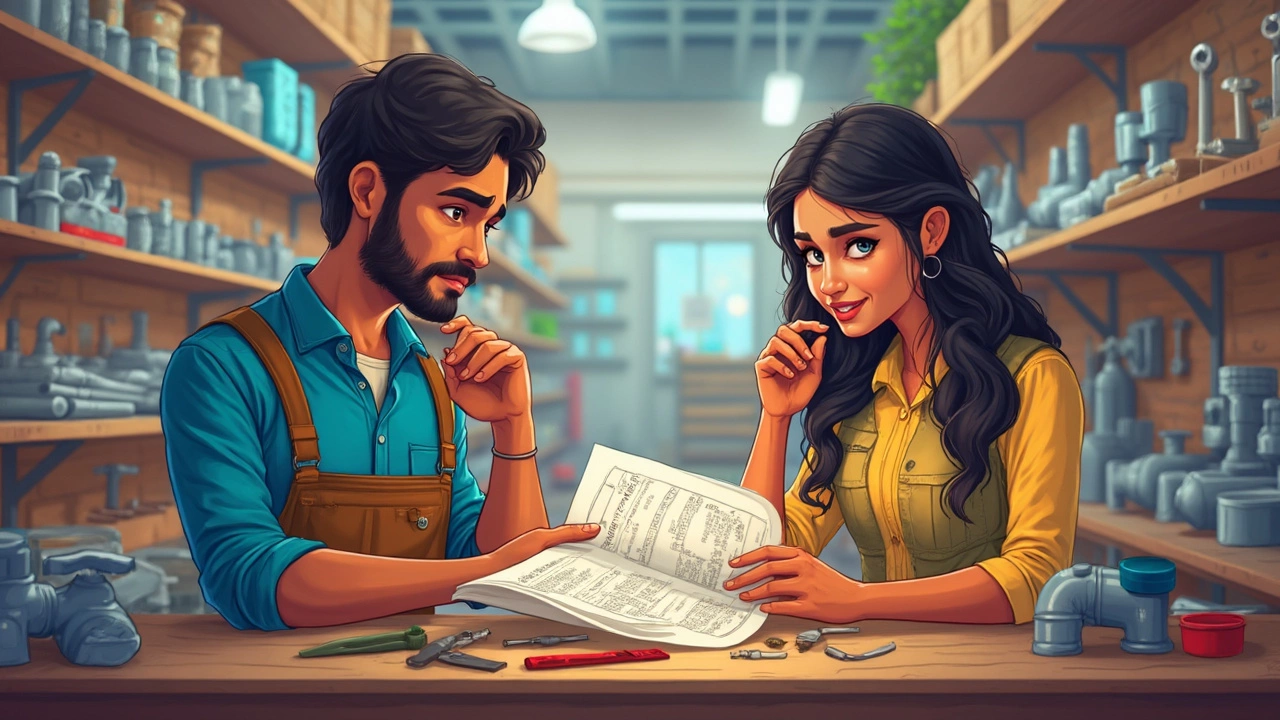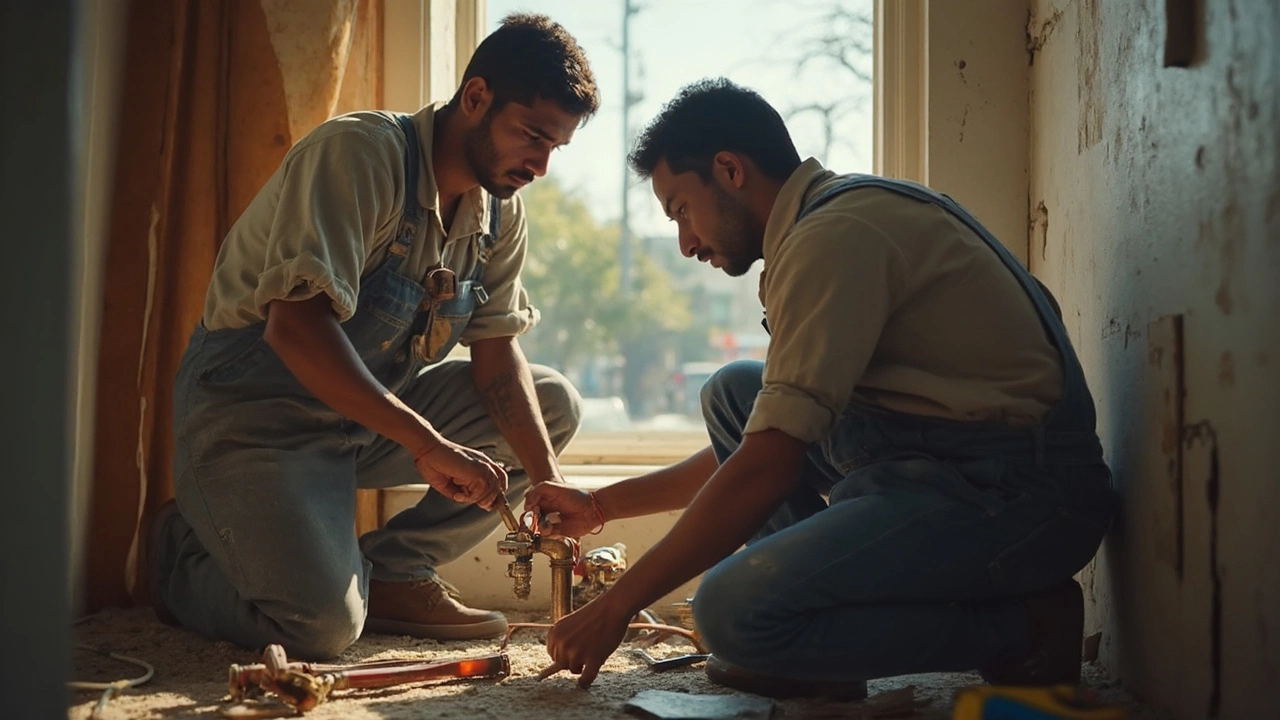Plumber Training Course: How Does Someone Become a Plumber?

If you’ve ever panicked over a leaking pipe at midnight, you know plumbers are real lifesavers. But how do you actually go from zero experience to being the person people call in a crisis? Breaking into plumbing is a solid move these days—there’s always a demand, and the pay isn’t bad, either. But it’s not just about grabbing a wrench and fixing sinks. It takes real training, both in the classroom and on the job, plus a bunch of hands-on practice before you can run your own show.
The path starts a lot sooner than most think. First, you need to know what you’re getting into—is plumbing going to suit you? If you like problem-solving, don’t mind rolling up your sleeves, and stay calm when water goes everywhere, you’re already off to a decent start. But even with the right attitude, you’ll need proper training (and, let’s be honest, a lot of patience for paperwork later).
Plumber training courses don’t just teach you how to fix a leaky faucet. You’ll learn about blueprints, local plumbing codes, safety rules, and even customer service. It’s a mix of book learning and doing—think of it as getting your hands dirty and your brain working at the same time. Most people kick things off by checking out local trade schools or community colleges. Pro tip: look for programs that include a good amount of actual on-site practice, not just lectures.
- Why Choose Plumbing as a Career?
- Basic Requirements to Start
- How Plumber Training Courses Work
- The Importance of Apprenticeships
- Licensing and Certification
- What Daily Life as a Plumber Looks Like
Why Choose Plumbing as a Career?
Think about it—every building you walk into needs plumbing. Homes, restaurants, hospitals, all rely on pipes that work right. Job security is real here. Even when things get shaky in the economy, people still need running water, toilets that flush, and someone who knows how to fix an unexpected flood.
One of the big draws? Plumbing pays pretty well considering you don’t need a four-year degree. Entry-level plumbers in the US take home an average of $47,000 a year, and experienced folks often make $70,000 or more. If you stick with it and run your own business, the numbers go up fast. Check out these national stats from 2024:
| Plumbing Role | Average Annual Salary |
|---|---|
| Entry-Level Apprentice | $36,000 |
| Licensed Journeyman | $56,000 |
| Master Plumber | $77,000 |
| Self-Employed/Contractor | $90,000+ |
But money isn’t everything. There’s a good feeling in solving real-world problems every day. If you’re choosing a career for stability, hands-on work, and the chance to build your own reputation, this is a solid option. The need for plumber training might sound like a hurdle, but it’s what makes you valuable—there’s no shortage of calls for skilled pros. Plus, you can choose to specialize later on in things like gas fitting or green technologies, which keeps things interesting.
Fun fact: according to the Bureau of Labor Statistics, the plumbing field is expected to grow 4% from 2022 to 2032—that’s thousands of new jobs each year. If you’re looking for something steady, practical, and always in demand, plumbing just makes sense.
Basic Requirements to Start
First thing—there’s no age limit for getting into plumbing, but most places expect you to be at least 18 to jump into a proper training course. You’ll need a high school diploma or a GED. Honestly, you don’t have to be a math genius, but being comfortable with basic math and measurements will save you a headache later on. Reading blueprints isn’t magic, but you have to be willing to learn.
Every state has its own rules, but here’s what you usually need before you can start a plumber training program:
- High school diploma or GED certificate
- Be at least 18 years old (sometimes 16 for pre-apprenticeships)
- Valid driver’s license (lots of site travel required)
- Physical ability—plumbing involves lifting pipes, crouching, and working in tight spots
- No recent serious criminal background (misdemeanors are often okay, felonies might not be)
Most programs ask for a short interview or assessment. They want to make sure you know what you’re signing up for and you’re serious about finishing the course. Some schools throw in a simple skills test (measuring, using hand tools, reading simple instructions) just to check you’re ready for hands-on work.
| Requirement | Why It Matters |
|---|---|
| High School Diploma / GED | Needed for applications and to follow technical info |
| Driver’s License | You have to get to jobs all over town |
| Physical Fitness | Plumbing is active—expect squats, crawling, and lifting |
| Basic Math Skills | Helps with measuring, cutting pipes, estimating materials |
| Clear Background | Many clients and worksites require background checks |
If you meet these basics, you’re good to start looking at training courses or apprenticeships. No need for fancy equipment or massive investments up front. A willingness to learn and a little determination goes a long way.
How Plumber Training Courses Work
Jumping into a plumber training course is a lot more hands-on than most folks expect. You don’t just sit in a classroom day after day copying notes. Most courses mix book-smarts with real-life skills. You'll cover things like reading blueprints, figuring out drainage systems, and spotting safety hazards – all the stuff you’ll need out on real jobs.
Your first day usually looks like a mix of safety talks (think: goggles, gloves, and avoiding a trip to the ER), some intro plumbing theory, and rolling up your sleeves to start practicing basic pipe fitting. Good programs let you use real tools almost right away. You might be fixing leaky joints in the lab by the end of your first week.
Typical topics you’ll tackle include:
- Plumbing codes and regulations – you’ll need to know these for your state or region
- Blueprint reading and measuring
- Working with different types of pipes (PVC, copper, PEX, and even old-school cast iron)
- Installing fixtures and appliances, like sinks, water heaters, and toilets
- Troubleshooting common household and commercial plumbing problems
- Basic welding and soldering
- Math for plumbers – mostly fractions, angles, and measurements
If you’re worried about cost, keep in mind most plumber training courses pay off fast. The Bureau of Labor Statistics found the average price for a full course at a community college is about $5,000 to $10,000, but you’ll start earning during apprenticeships.
| Program Type | Typical Length | Average Cost (US) |
|---|---|---|
| Certificate Course | 6-12 months | $3,000 - $7,000 |
| Associate Degree | 2 years | $8,000 - $18,000 |
| Apprenticeship | 4-5 years | Paid (Earn While You Learn) |
After finishing your training course, you’re not done yet. Most states want proof of your classroom hours and a certain amount of time logged under a licensed plumber before you can take the license exam. It’s a bit like getting your driver’s license – lots of practice, then a final test before you’re allowed to work on your own.

The Importance of Apprenticeships
You can read books and ace every classroom test, but nothing beats actually crawling under a sink to fix a mess. That’s why apprenticeships are the backbone of becoming a plumber. Most states require you to spend anywhere from two to five years as an apprentice before you can even think about getting licensed. During this time, you’ll work side-by-side with licensed pros, picking up everything they didn’t teach you in class.
So, what does an apprenticeship actually look like? You’re not just watching—you're helping with real jobs most of the time. Think installing toilets, running pipes, troubleshooting weird problems nobody covered in the course. You’ll also learn the right way to use tools and follow safety codes, which keeps you and homeowners out of trouble. The pay starts modest but goes up as you get better and tackle more complex jobs.
- Most programs last 4 years and combine on-the-job training with about 200 classroom hours per year.
- As an apprentice, you get paid while you learn—a big plus compared to racking up college debt without income.
- Many big plumbing companies and local unions offer formal programs that help you line up steady work and get mentorship.
Here’s a quick look at what plumbers in training actually earn across the U.S.:
| Year of Apprenticeship | Average Hourly Pay | Total Classroom Hours |
|---|---|---|
| 1st Year | $15–$18 | 200 |
| 2nd Year | $18–$21 | 200 |
| 3rd Year | $21–$24 | 200 |
| 4th Year | $24–$28 | 200 |
If you're serious about starting a plumber training journey, jumping into an apprenticeship is a must. Don’t settle for a program that just tosses you into the field with zero support. Look for mentors who want to see you succeed and companies that will let you try the tougher jobs, not just sweep the floors. That way, you’ll build real skills and be ready to ace the licensing test when your time comes.
Licensing and Certification
Alright, so you’ve got your training done and survived the apprenticeship grind, but before you can call yourself a real plumber and take on jobs solo, you need to get licensed. This isn’t just a box to check—it’s the law in most places. Every state in the US has its own rules for licensing, and some cities have extra requirements stacked on top. Usually, you’ll need to prove you’ve finished a certain number of hours, like 2,000 to 8,000 hours of on-the-job training (depending on the state), plus another chunk of classroom time.
Getting your plumbing license usually goes something like this:
- Finish your formal training or apprenticeship—make sure your hours are logged and signed off.
- Apply to sit for your state’s exam. These tests cover everything you actually need on the job: safety, local plumbing codes, and practical problem solving.
- Pass the written and sometimes hands-on test. These aren’t meant to trip you up, but you do need to know your stuff. For example, in Texas, you’ll have to score at least 70% to pass.
- Submit your paperwork, sometimes including a background check and a fee. Expect a bit of waiting here—some places process licenses in a few weeks; others might take longer.
Don’t forget: many states also ask you to keep learning even after you’re licensed. “Continuing education” courses keep you updated with new laws and tech. Let’s face it, the tools keep changing, and nobody wants to show up without knowing the latest code updates.
If you want to go beyond being a regular plumber—say, run your own business or work on bigger commercial projects—you’ll likely need extra certifications. Some people even get specialty licenses, like for gas lines or fire sprinklers. The upside? More skills can mean bigger jobs and better pay.
No matter where you’re starting, getting your plumber certification is a must if you want to turn plumbing into a steady career. Skip this step, and you’ll miss out on real work and better pay. Stick with it, and doors start to open up.
What Daily Life as a Plumber Looks Like
So, what does a plumber actually do each day? Forget the stereotypes—there’s a lot more to it than unclogging toilets. Work starts early because most plumbing jobs happen during the day while places are open, and demand sometimes stretches into nights and weekends for emergency calls.
Typical days run the gamut: you might be fixing leaks in someone’s kitchen one hour, then heading to a big construction site the next. Some plumbers specialize—like only doing residential work—while others jump between homes, offices, restaurants, even huge factories. No two days are ever the same.
Here’s what usually lands on a plumber’s plate:
- Inspecting and repairing pipes, fixtures, and plumbing systems
- Reading blueprints and understanding building codes
- Installing new systems in buildings under construction
- Talking to customers and helping them understand the work
- Keeping up with the latest safety standards and plumbing skills
- Handling paperwork—especially if you run your own business
Some plumbers handle only big commercial jobs, while others stick to homes. Big cities often see more complicated projects, while in small towns, flexibility is key since you’ll handle anything thrown your way.
Check out how a typical workweek can look for a plumber:
| Day | Typical Tasks | Common Work Setting |
|---|---|---|
| Monday | Emergency repairs, cleaning drains | Residential homes |
| Tuesday | New pipe installations, blueprint reading | Construction sites |
| Wednesday | Boiler maintenance, checking water heaters | Commercial buildings |
| Thursday | Renovation projects, updating old systems | Restaurants/offices |
| Friday | Customer quotes, business paperwork | Home office, client sites |
Expect to be on your feet a lot, crawl under sinks, and sometimes squeeze into weirdly tight spots. It’s physical work and can get muddy—sometimes smelly, too—so a good attitude helps. If you like solving puzzles and don’t mind the occasional wrench thrown your way (pun totally intended), you’ll fit right in. Oh, and if you own your business, you’re juggling jobs, phone calls, and keeping customers happy—so it’s always lively, never boring.

Post-Comment